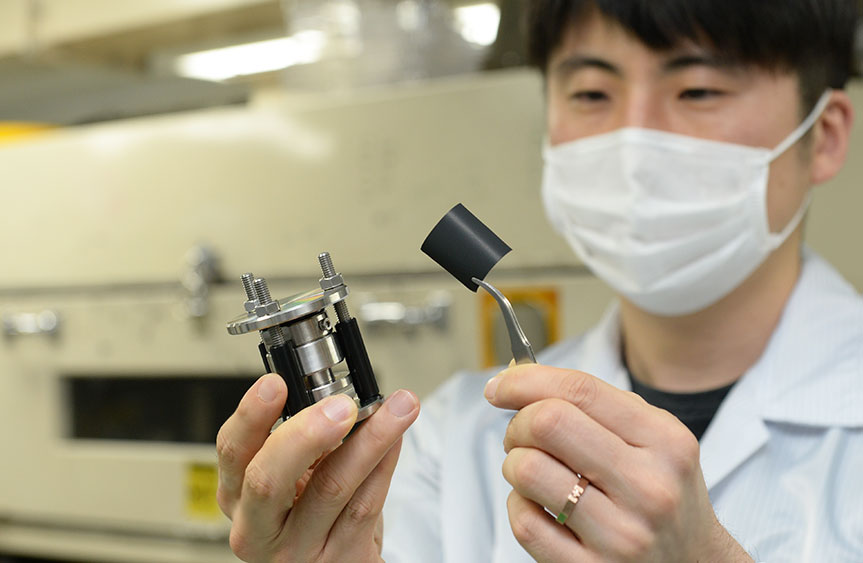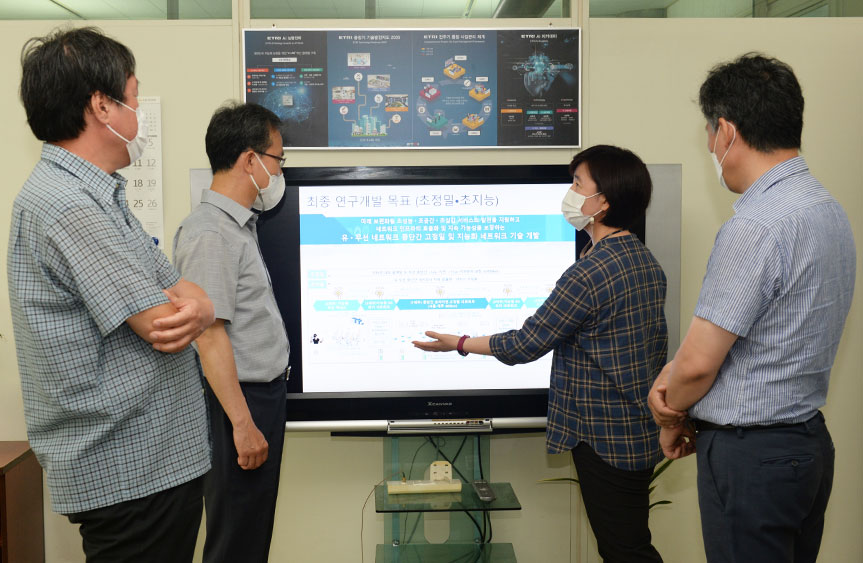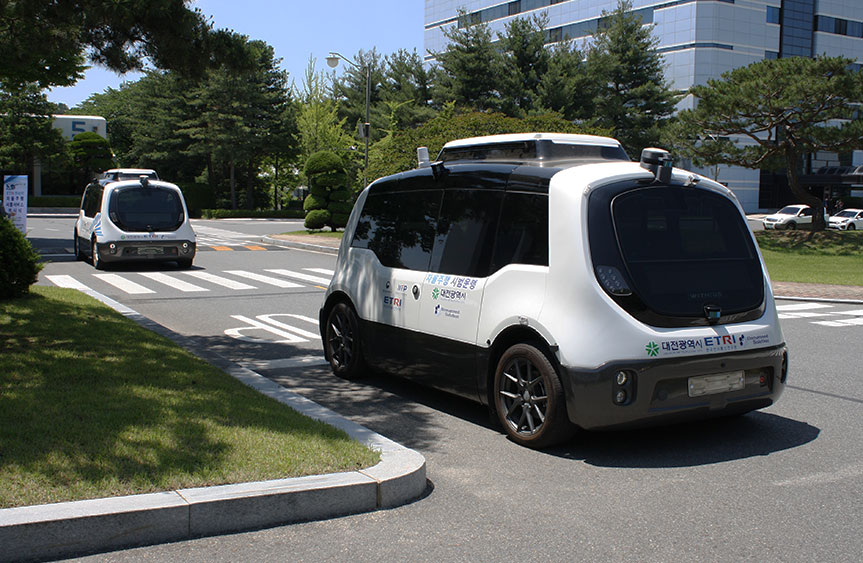VOL. 66 August 2021
News 1
ETRI Developed an Anode for Secondary Batteries without Solid Electrolyte
- Proposed an anode composed of active titanium disulfide (TiS2) material and binder only
- Identified diffusion characteristics between particles with DGIST, and increased energy density by 1.3 times

The Electronics and Telecommunications Research Institute (ETRI) announced that it has developed a new electrode structure based on an anode using only titanium disulfide (TiS2) as an active material without a solid electrolyte. This exceptional development result was proved as shown in the online post on “Energy Storage Materials”1) last month, which is an accredited academic journal worldwide.
Last year, the research team has developed an anode structure, followed by the development of all-solid-state secondary batteries. This technology is likely to significantly help the realization of safe and high-performance all-solid-state secondary batteries.
The all-solid-state secondary battery is a next-generation battery that uses a solid as the electrolyte that transfers ions in the battery. A solid electrolyte is more fire-retardant than a liquid electrolyte, which is flammable. It is also optimal to increase energy density because a bipolar-type secondary battery2) can be made, which is not possible using a lithium-ion battery.
ETRI proposed a battery structure that constitutes an anode with the active material, which removes any gaps between particles by applying pressure to TiS2 without a solid electrolyte and binder only.
With the joint research team of Daegu Gyeongbuk Institute of Science and Technology (DGIST)3), ETRI confirmed that lithium ions directly diffuses through titanium disulfide particles, and this result proved that a high-performance all-solid-state secondary battery can be achieved with only an anode structure without a solid electrolyte.
The research team said that they can achieve excellent results by theoretically forecasting and experimentally verifying that the electrochemical performance can be significantly increased by converting the active material into nano. This is in part attributed to their proven experience and know-how on developing a cathode structure based on graphite.
ETRI also confirmed that energy density can be increased by 1.3 times more than using a solid electrolyte with the same capacity because the content of the active material can be increased as much as the unused solid electrolyte.
It can also significantly contribute to the performance improvement of all-solid-state secondary batteries and price competitiveness because any solvents and binders can be selected, and the existing plate manufacturing process of the lithium-ion battery can be used without changing it.
1) Energy Storage Materials IF: 16.28, JCR by field: 94.042
2) A high-voltage secondary battery composed of a simple structure, as electrodes are connected in series in a secondary battery.
A liquid electrolyte requires a more complex structure to prevent possible leaks, which reduces energy density.
3) Level 2~3 defined based on the definition of automation level classified by the SAE (Society of Automotive Engineers) on the autonomous vehicle
News 2
ETRI Was Selected As a Management Institute for the 6G Core Technology Department Project
- Joint research by 37 industrial, academic and research institutes including three mobile operators, Samsung Electronics and KAIST
- To achieve super-performance, super-broadband, hyperspace, super intelligence and ultra-precision transmission with terahertz

The Electronics and Telecommunications Research Institute (ETRI) announced that it was selected as a management institute for the “6G core technology development project” participated by 37 research institutes including the big three mobile communication service providers, Samsung Electronics and KAIST.
The research team divided the 6G research project into five major areas1) and participating institutes were delegated a total of 8 strategic tasks2) for each area.
Firstly, the super-performance and super-broadband area aims to secure a terabyte (Tbps)-class transmission rate in the terahertz (Thz) range3) which is a candidate band for 6G4). The research team expects that large-capacity data services can be provided at faster transmission speed than by developing wireless communication, optical communication, RF components and safety evaluation technology using this frequency band.
Although the hyperspace field is yet to exist, this team will focus on developing “3D spatial satellite communication technology” to provide giga (Gbps) services in even offshore or remote areas and times of disaster by converging, using mobile communication and satellite communication technology. To overcome the limitations of current mobile communication services, the project plans to research a new technology at ground-level (altitude 120m or less) and to enable smooth communication in fast-moving vehicles, airplanes and drones.
The super-intelligence and ultra-precision transmission team will make the network infrastructure more efficient by developing ▲ “intelligent wireless access technology” that supports seamless connection in a frequently interrupted environment, ▲ “intelligent 6G core network technology” that provides personalized services for users ▲ “end-to-end high-precision network technology” that minimizes inaccuracies due to data latency even from afar.
ETRI has a proven and long history in ICT development by leading the information revolution in Korea, ranging from TDX to 5G technology development. In line with this, ETRI plans to strengthen national competitiveness in mobile communication technology by developing core 6G technology in collaboration with other research institutes and making the entire industry intelligent.
ETRI moved quickly to secure next-generation mobile communication technology by signing an MOU for joint research on 6G with the University of Oulu in Finland in 2019.
1) Super performance, super broadband, hyperspace, ultra-precision, and super intelligence
2) Development of ① Tbps wireless communication technology, ② Tbps optical communication infrastructure technology, ③ THz band RF core parts development, ④ THz band frequency opening and safety evaluation technology, ⑤ 3D spatial satellite communication technology, ⑥ 3D space mobile communication technology, ⑦ end-to-end high precision network technology, ⑧ and intelligent wireless access technology.
3) 100∼300㎓
4) Electromagnetic waves with frequencies between 0.3 GHz and 3 THz, which have the advantage of reducing power consumption by improving communication efficiency and sending integrated signals.
News 3
ETRI Operates a Self-driving Shuttle
Bus with No Drivers
- Obtained Korea’s first temporary operation permit by applying AI to SME’s electric cars
- Pioneering the era of level 4 autonomous driving with voice control and realistic content

The self-driving car developed by the research team is called AutoVe, which combines “Autonomous Driving” and “Vehicle” to express true autonomous driving technology without a driver.
On the 9th, the Electronics and Telecommunications Research Institute (ETRI) announced that it will provide a test shuttle bus service that circles the research institute by developing autonomous driving technology based on the highest level of artificial intelligence (AI) technology in Korea.
Currently, commercialized autonomous driving technology is currently at automation level 2 or 3, which requires a steering wheel in a car or human intervention for unexpected scenarios. But ETRI has fully prepared for the era of level 4 autonomous driving by developing a technology that makes cars with no driver’s seat a reality.
The technology developed by the research team will be widely used for the platform service, which provides hyper-realistic content in real time as the passenger leisurely gets to the destination, especially useful for passengers who don’t own or drive a car.
The research team applied a high-performance AI algorithm to AutoVe, which processes the information obtained from cameras and radar sensors in real time to recognize the environment, surrounding conditions and objects and to plan a driving route by itself. This method is more efficient than processing sensor information by communicating with servers in a remote place.
For this study, ETRI built domestic road and traffic environment data (100,000 km) and 14 million sheet of learning data (200 TB). The research team will share related data with other research institutes and collaborating companies, and contribute to advancing the local AI and autonomous driving industry ecosystem by pursuing research on performance improvement, stabilization and optimization of the algorithm1), eco-friendly service, and autonomous driving service for mobility handicaps.
This project is conducted as part of the “innovative technology development project for the ICT convergence industry” (the Ministry of Information and Communication) and “R&D support project” (ETRI). Its aim is to commercialize full-self-driving cars in 2027 by serving as the roadmap for future innovation projects of autonomous driving technology development.
1) Mobility as a Service
